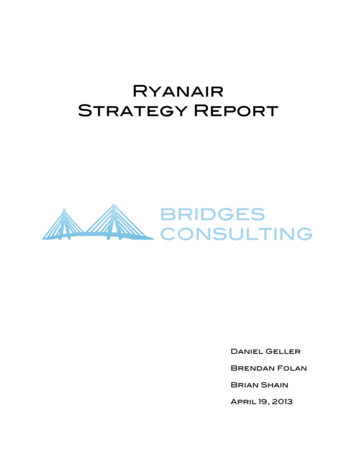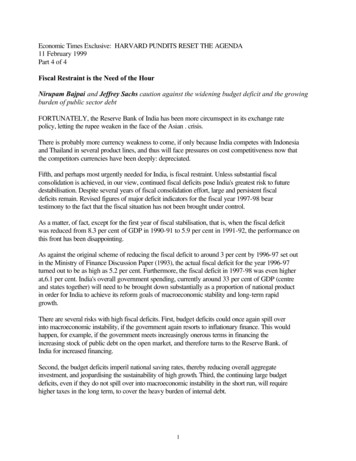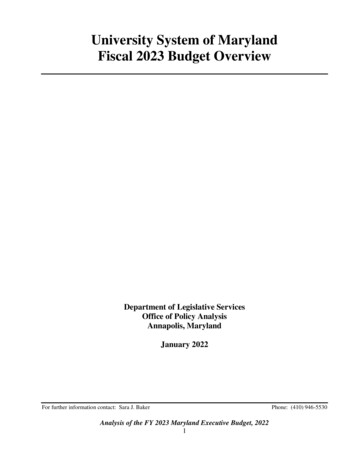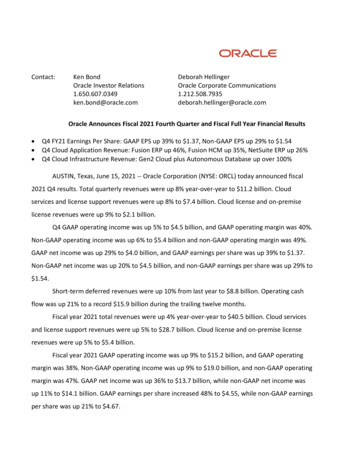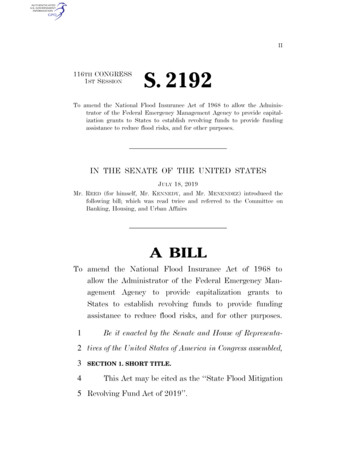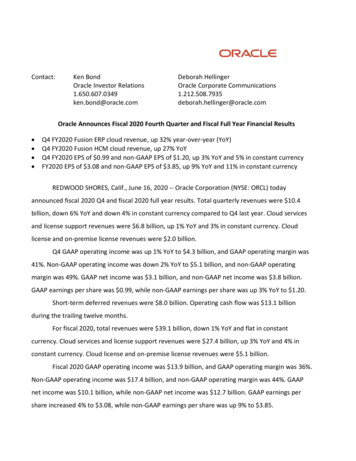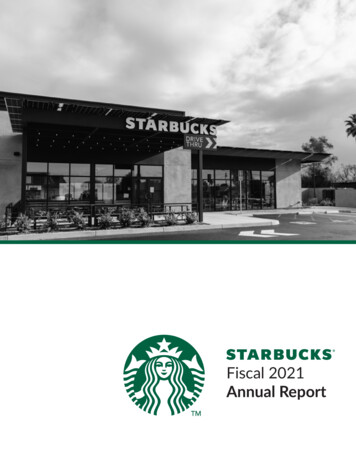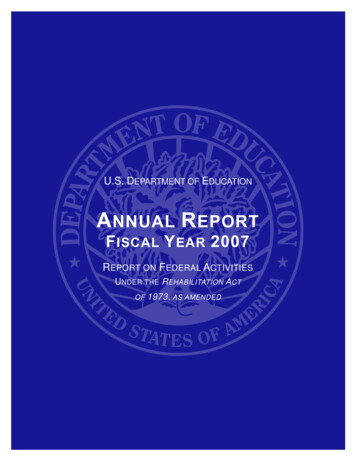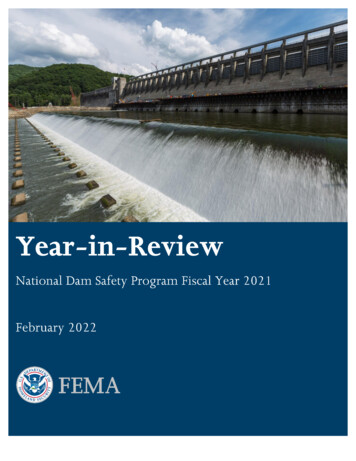
Transcription
Fiscal Year 2021 Year-in-ReviewThis page intentionally left blank.National Dam Safety Program
Fiscal Year 2021 Year-in-ReviewTable of ContentsYear-in-Review .11.2.3.4.Trainings .11.1.Emergency Management Institute (EMI): Virtual National Dam Safety ProgramTechnical Seminar – Feb. 16-19, 2021 . 11.2.Collaborative Technical Assistance . 21.3.Dam Failure Life Loss Consequence Virtual Workshop – May 17-19, 2021 . 21.4.Learning Content Management System (LCMS) Seepage and Internal ErosionCourses . 3Publications/Reports/Resources .42.1.FEMA National Dam Safety Program Overview Fact Sheet . 42.2.National Dam Safety Awareness Day Outreach Materials . 42.3.Federal Guidelines Updates . 52.4.Decision Support System for Water Infrastructure Security (DSS-WISE) 3.0 . 5Grants .63.1.FY 2021 State Assistance Grants . 63.2.Rehabilitation of High Hazard Potential Dams (HHPD) Grant . 6Conferences/Presentations .74.1.Dam Safety 2021: Association of State Dam Safety Officials Annual Conference –Nashville, Tennessee . 74.2.United States Society on Dams Annual Conference – Virtual . 8National Dam Safety Programi
Fiscal Year 2021 Year-in-ReviewYear-in-ReviewThe National Dam Safety Program (NDSP) is a partnership of public and private sector stakeholdersthat promotes the establishment and maintenance of effective federal and state dam safetyprograms to reduce the risks to human life, property, and the environment from dam-relatedhazards.The program began to publish this series to showcase essential NDSP accomplishments. Thisdocument is devoted to accomplishments that occurred during Fiscal Year (FY) 2021. It provides thedam safety community, as well as the public, a heightened understanding of the Program’sobjectives: to reduce the risk associated with dams and promote the benefits of dam safety.To promote dam safety, FEMA coordinates with federal, state, and private sector partners through: The National Dam Safety Review Board (NDSRB), comprised of federal, state, and private sectorpartners, advises FEMA’s administrator in setting dam safety priorities. The board also consultsthe administrator on the effects of dam safety policy. The Interagency Committee on Dam Safety (ICODS), comprised of federal agencies having aninvolvement with dams, was founded in 1980 to encourage the establishment and maintenanceof effective federal programs, guidelines, and policies to enhance dam safety and security.Table 1. Accomplishments for Fiscal Year 2021Program HighlightsTotal Training/Collaborative TechnicalAssistance Sessions15Training ParticipantsMore than 802New updated guidance or tools101.1.1.TrainingsEmergency Management Institute (EMI): Virtual National Dam SafetyProgram Technical Seminar – Feb. 16-19, 2021The National Dam Safety Review Board Work Group on Dam Safety Training welcomed all dam andlevee safety professionals and those responsible for responding to dam and levee safety incidents tothe annual National Dam Safety Program Technical Seminar (NDSPTS). The annual technicalseminar took place virtually, Feb. 16-19, 2021. The topic for this year’s seminar was Risk-InformedDecision Making (RIDM) and Benefit-Cost Analysis (BCA) for Dam and Levee Projects which includedNational Dam Safety Program1
Fiscal Year 2021 Year-in-Reviewpresentations focused on challenges, benefits, tools, and success stories of RIDM and BCA. In total,322 individuals were in attendance.Figure 1. 2021 Virtual National Dam Safety Program Technical Seminar1.2.Collaborative Technical AssistanceThe FEMA Collaborative Technical Assistance (CTA) series helps communities at risk of dam-relatedflooding to better understand their risk landscape and the potential consequences of dam-relatedemergencies. This technical assistance includes planning for emergencies related to operationaldischarges or dam-related infrastructure failure. In FY 2021, the FEMA program worked with onecohort – San Diego County, California. There was a total of eight sessions in addition to four officehours with a total of 420 participants.1.3.Dam Failure Life Loss Consequence Virtual Workshop – May 17-19,2021This workshop provided dam owners, emergency managers, and other relevant stakeholders with theinformation needed to define and estimate consequences for dam failure scenarios. The course alsohighlighted the importance of defining dam failure scenarios and assessing life loss consequencesthrough the presentation of tools and case studies. Due to COVID-19, this workshop was heldvirtually and had 60 participants.National Dam Safety Program2
Fiscal Year 2021 Year-in-ReviewFigure 2. 2021 Dam Failure Life Loss Consequence Virtual Workshop1.4.Learning Content Management System (LCMS) Seepage and InternalErosion CoursesThe FEMA NDSP worked with EMI to develop three LCMS courses based on FEMA P-1032,Evaluation of Monitoring of Seepage and Internal Erosion. The courses provide dam owners,emergency response personnel and other stakeholders with the knowledge and tools to identifyseepage and internal erosion within dams. Course IS-0874, Introduction to Seepage and Internal Erosion and the Emergency Response toSeepage Related Dam Risks, is the first part of the three-part series. The course provides a basiclevel introduction to the concepts and implications of seepage and internal erosion and builds afoundation for private dam owners, local, state, tribal and territorial officials to understandseepage-related dam risks. Course IS-0875, Identifying, Monitoring, and Addressing Seepage and Internal Erosion at Dams,provides a basic introduction to identifying, monitoring, and addressing seepage and internalerosions at dams. Course IS-0876, Evaluation and Analysis of Internal Erosion and Seepage Conditions at Dams,builds competency in the investigation and analysis of seepage and internal erosion at dams. Italso builds a foundation for local emergency officials and engineers on seepage conditions asthey pertain to risk-based systems.National Dam Safety Program3
Fiscal Year 2021 Year-in-ReviewFigure 3. LCMS Course Welcome Screen2.Publications/Reports/Resources2.1.FEMA National Dam Safety Program Overview Fact SheetThis fact sheet was developed to give an overview of the Program and breaks down the differentcomponents – partnerships, grants, training, research and public safety and awareness. The factsheet can be viewed here.2.2.National Dam Safety Awareness Day Outreach MaterialsIn FY 2021, FEMA NDSP created the following resources to help the dam safety community promoteand participate in National Dam Safety Awareness Day.1. Event planning checklist – A list of things to consider when planning your local dam safety event.2. Key messages – A list of short talking points to help start conversations about dam safety.3. Template news release – A pre-approved news release with standard boilerplate language foruse by local champions in promoting National Dam Safety Awareness Day. Also included isguidance for engaging members of the media.4. Web and social media content – Suggested content for promoting local events on your websiteor social media accounts. Also included is guidance for sharing stories and/or photos by usingthe #DamSafetyDay hashtag on Facebook, Twitter, Instagram, and LinkedIn.5. Activities for kids – FEMA has prepared a list of suggested activities for engaging children, whichhelps kids to be more risk-aware. It is also an effective way to engage their parents and otherfamily members.National Dam Safety Program4
Fiscal Year 2021 Year-in-ReviewDam Safety Awareness Day is on May 31 and was established to commemorate the failure of theSouth Fork Dam in Johnstown, Pennsylvania. The Johnstown disaster was the worst dam failure inthe history of the United States, with over 2,200 lives lost. National Dam Safety Awareness Dayseeks to encourage and promote individual and community responsibility and best practices for damsafety, as well as what steps can be taken to prevent catastrophic dam failures.2.3.Federal Guidelines UpdatesThe FEMA NDSP, in coordination with ICODS and NDSRB, formed four task/work groups to beginupdating the following Federal Guideline documents: FEMA P-64 – Emergency Action Planning for Dam OwnersFEMA P-65 – Earthquake Analyses and Design of DamsFEMA 93 – Federal Guidelines for Dam SafetyFEMA P-148 – Glossary of Terms2.4.Decision Support System for Water Infrastructure Security (DSS-WISE)3.0The National Center for Computational Hydroscience and Engineering (NCCHE) at the University ofMississippi recently released the new beta version 3.0 of the DSS-WISE Web system. This was donein coordination with the U.S. Department of Homeland Security Science and Technology Directorate,the Federal Emergency Management Agency National Dam Safety Program, and the CaliforniaDepartment of Water Resources Division of Safety of Dams.This update builds upon the previous version 2.0 with a host of powerful new features and aredesigned user interface to assist dam safety professionals, dam safety regulators, communityofficials, and emergency managers with dam break and flood hazard inundation mapping. Thesenew capabilities and enhancements include the following:1.A completely redesigned web user interface.2.An improved, contextualized help system.3.The generation of intermediate results upon user request.4.A new dam NID search tool.5.A new point query tool for results.6.An improved breach parameter calculator.7.Improvements to the results package.8.The ability to load new simulation parameters from a previous submission.9.The ability to include the presence of user-drawn levees.10. The ability to model dams in series.National Dam Safety Program5
Fiscal Year 2021 Year-in-ReviewFigure 4. Updates featured in DSS-WISE 3.03.3.1.GrantsFY 2021 State Assistance GrantsA total of 5.9 million was awarded in FY 2021. The purpose of the State Assistance Grant is toprovide financial assistance to states for strengthening their dam safety programs.3.2.Rehabilitation of High Hazard Potential Dams (HHPD) GrantThe President signed the “Water Infrastructure Improvements for the Nation Act”, also known as the“WIIN Act,” on Dec. 16, 2016, which added a new grant program under FEMA’s National Dam SafetyProgram (33 U.S.C. 467f). Section 5006 of the Act, Rehabilitation of High Hazard Potential Dams,provides technical, planning, design, and construction assistance in the form of grants for therehabilitation of eligible high hazard potential dams. In FY 2021, FEMA received 12 million toimplement the Rehabilitation of High Hazard Potential Dams Grant Program. This grant providesassistance with planning and other construction activities. There was a total of 15 awardees.Table 2. Fiscal Year 2021 High Hazard Potential Dam Grant HighlightsProgram HighlightsTotal Award Recipients15Funds Allocated 12 millionHotline Questions AnsweredMore than 60National Dam Safety Program6
Fiscal Year 2021 Year-in-Review4.4.1.Conferences/PresentationsDam Safety 2021: Association of State Dam Safety Officials AnnualConference – Nashville, TennesseeThe NDSP attended and exhibited at the Association of State Dam Safety Officials (ASDSO) AnnualConference in Nashville, Tenn. from Sept. 12-15, 2021. On Thursday, Sept. 16, 2021, PrestonWilson of the FEMA NDSP spoke with 19 seniors at Tennessee State University, a Historically BlackCollege and University. These students are a part of Tennessee State University’s Civil andArchitectural Engineering program. Preston discussed how dam safety fits into FEMA’s mission andhow dam safety is an exciting industry that requires civil engineers to utilize skills and resourcesfrom multiple civil engineering subdisciplines. In addition, he discussed the important role that CivilEngineers have in Emergency Management, including critical infrastructure and helping communitiesunderstand the impacts of these essential lifelines.Figure 5. FEMA's Preston Wilson presents to Tennessee State University StudentsThe NDSP also invited four graduate and doctorate level Civil and Architectural Engineering studentsto attend the ASDSO conference. The conference sessions included a variety of workshops,presentations, and meetings related to current topics within dam safety, including climate change,new technology and resilience.National Dam Safety Program7
Fiscal Year 2021 Year-in-ReviewFigure 6. Civil and Architectural Engineering students attending the ASDSO Conference4.2.United States Society on Dams Annual Conference – VirtualThe FEMA NDSP also participated in the United States Society on Dams Annual Conference from May10-21, 2021. Due to the ongoing COVID-19 pandemic, the conference was held over a two-weekperiod. James Demby and Preston Wilson of the FEMA NDSP also participated in the presentation“From Reacting to Preparing: The History of Emergency Action Plans for Dams” during theconference.National Dam Safety Program8
1.4. Learning Content Management System (LCMS) Seepage and Internal Erosion Courses The FEMA NDSP worked with EMI to develop three LCMS courses based on FEMA P-1032, Evaluation of Monitoring of Seepage and Internal Erosion. The courses provide dam owners, emergency response personnel and other stakeholders with the knowledge and tools to identify
